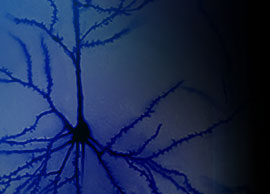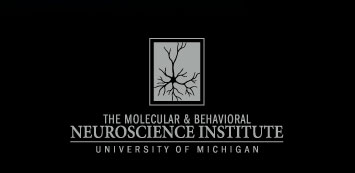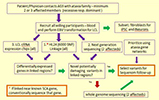


| By Alpha|By Interest|Emeritus | ||
|
734-647-2186 |
 |
Current Research Interests:Genes of Brain DisordersWe are using genetic information to find the genes involved in brain disorders, then dissect the disease process. We have identified deafness and other neurological disorder genes and now focus on ataxias as well as psychiatric diseases and behavior. There are about 100 known ataxia genes, some of which our lab discovered. Our pipeline starts with recruitment of families with rare disorders, then combines genetic (linkage) information with genome-wide gene expression and next generation sequencing. By combining these approaches, we can identify genes involved in ataxias, and are actively recruiting additional families with rare neurological disorders. Human behavior and risk for psychiatric illness such as depression and alcoholism are determined by a complex interaction of environmental and multiple genetic risk factors. With the Human Genome sequenced, unprecedented numbers of genetic variants identified, and novel technologies that allow the study of genetic variants, untangling these risk factors is now possible, using genome-wide association studies (GWAS) and next generation sequencing. For most complex disorders, considering the environment as well as the genetic susceptibility is essential to fully understand their function. With regard to depression, we are studying some known environmental factors such as stress. A former student and now colleague, Srijan Sen, uses the medical internship as a specific, predictable stressor (https://www.srijan-sen-lab.com/intern-health-study). We are collaborating with him in genetic studies, and have expanded this study to several Chinese Universities. I spend several months each year teaching in China and also have several active collaborations. We collaborate with clinicians, psychologists, epidemiologists, statisticians and bioinformaticians as well as other geneticists in these endeavors.
Honors and Awards:Distinguished Professor, Bio-X Center, Shanghai Jiao Tong University, China Michael Weston Visiting Professorship, Weizmann Inst. of Science, Rehovot, Israel Fellow of the "Studienstiftung des Deutschen Volkes" (German Phi Beta Kappa Equivalent). Postdoctoral Fellowship from the German Academic Exchange Committee (DAAD). NARSAD Distinguished Investigator Award 2008 and many earlier NARSAD awards Klingenstein Fellowship Award in the Neurosciences. Alexander von Humboldt Foundation Fellowship for Sabbatical in Berlin, Germany. EBS-MBNI Teaching Award 2016 Selected Publications:
Fang Y, Scott L, Song P, Burmeister M, Sen S.
Caglayan AO, Gumus H, Sandford E, Kubisiak TL, Ma Q, Ozel AB, Per H, Li JZ, Shakkottai VG, Burmeister M.
Yan H, Helman G, Murthy GS, Ji H, Crawford J, Kubisiak T, Bent SJ, Xiao J, Taft RJ, Coombs AA, Wu Y, Pop A, Li D, de Vries LS, Jiang Y, Salomons GS, van der Knaap M, Patapoutian A, Simons C, Burmeister M, Wang J and Wolf NI.
Li HD, Bai T, Sandford E, Burmeister M, Guan Y.
Seong E, Insolera R, Dulovic M, Kamsteeg EJ, Trinh J, Brüggemann N, Sandford E, Li S, Ozel AB, Li JZ, Jewett T, Kievit AJA, Münchau A, Shakkottai V, Klein C, Collins CA, Lohmann K, van de Warrenburg BP, Burmeister M.
Trucco EM, Villafuerte S, Burmeister M, Zucker RA.
Kim M, Sandford E, Gatica D, Qiu Y, Liu X, Zheng Y, Schulman BA, Xu J, Semple I, Ro SH, Kim B, Mavioglu RN, Tolun A, Jipa A, Takats S, Karpati M, Li JZ, Yapici Z, Juhasz G, Lee JH, Klionsky DJ, Burmeister M.
Liu C, Saffen D, Schulze TG, Burmeister M, Sham PC, Yao Y-G, Kuo P-H, Chen C, An Y, Dai J, Yue W, Li MX, Xue H, Su B, Chen L, Shi Y, Qiao M, Liu T, Xia K, Shugart YY.
Burns R, Majczenko K, Xu JS, Peng W, Yapici Z, Dowling JJ, Li JZ, Burmeister M.
Villafuerte SM, Trucco EM, Heitzeg MM, Burmeister M, Zucker RA.
Sandford E, Burmeister M.
Villafuerte S, Strumba V, Stoltenberg S, Zucker RA, Burmeister M.
Villafuerte S, Heitzeg MM, Foley S, Yau WYW, Majczenko K, Zubieta JK, Zucker RA, Burmeister M.
Li MD, Burmeister M.
Burmeister M, McInnis MG, and Zoellner S. Links to additional information about the work of Dr. Burmeister.Department of Human Genetics, University of Michigan Bioinformatics Graduate Program
Depression is thought to be caused by a combination of genetic factors, early experiences and stressful life events. Instead of comparing depressed subjects and controls, research on the genetics of personality can get at genetic predisposition genes for depression even while studying a general population sample.
Genetic vulnerabilities for psychiatric disorders are shown as emerging from the extreme end of normal population variations of personality, illustrated as different background shades of mood, anxiety, cognitive processing and volition. Genetic factors affecting levels of these underlying traits, in interaction with additional genetic and environmental factors, can lead to psychiatric disorders — shown here are bipolar disorder, schizophrenia, depression and anxiety disorders — the symptoms and genetic risk factors of which are in part unique and in part overlapping. Because not all disorders can be covered in two dimensions, interactions and overlaps exist in many more dimensions than can be represented here.
|
||


 |
UM Gateway | UMMS | UMHS |
| Copyright © 2005 The Regents of the University of Michigan | |


